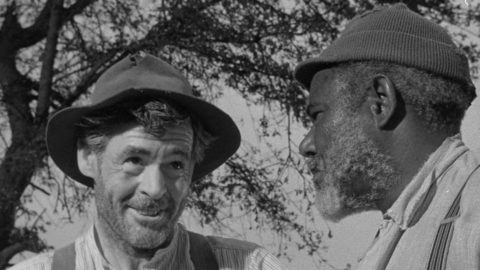TCM Diary: Borzage’s Strange Cargo

For a film that eventually turns into an audacious Christ allegory, Strange Cargo (1940) has its fair share of cynicism, sex, and romance. The first two elements can be credited in large part to stars Clark Gable and Joan Crawford, while director Frank Borzage, the cinema’s great romanticist, provides the final one. This is in spite of the fact that Borzage is working outside of his most recognized comfort zone of interior-set, closeup-maximizing melodrama, the milieu of such classics as 7th Heaven (1927), Lucky Star (1929), and History Is Made at Night (1937). Here he is dabbling in prison escape and seafaring action set in and off the jungles of Devil’s Island in French Guiana, and though he worked in many different genres and modes throughout a prolific career and the rugged wilds are MGM re-creations, he was rarely quite so out of his element. The worshipful deference to the power of love above the petty mundanities of daily existence marks Strange Cargo as Borzagian, while the “broader, more mystical vision of a transcendent harmony between man and nature” is what led Dave Kehr to call it “pivotal” Borzage. The same year’s masterpiece The Mortal Storm, with its warnings of Nazism’s desire to wipe out love (and all else) in the world and its thrilling snowbound chase finale, reflects this same pivot. Even if Borzage would never go so far as to demote individual connection and amour to “a hill of beans,” in 1940 the shape of his fixations had morphed into something more capacious.
Before Strange Cargo gives itself over to the sea and Christ, it’s content to be a hard-edged, borderline-nasty prison movie, with backstabbing inmates braining each other with shoes and rocks, and wardens, jailbirds, and ladies alike disparaging the local snitch (Peter Lorre) with epithets like “vermin,” “maggot,” and “pig” (in their defense, the character’s last name is Pig). Gable’s ill-behaved prisoner Verne is introduced in solitary confinement, a slit providing a glimpse of those instantly recognizable eyes, before the door is opened to reveal the star amply bearded and drenched in stage sweat. Rousted out of solitary, Verne is slapped with wharf duty, lugging man-size bags of grain and whatnot to and fro, when he sees Crawford’s Julie, who gets her own star entrance, alighting her carriage carrying a jaunty parasol, spinning towards the camera and asking, “mail for me?” Julie is a cafe “entertainer” down from the States to bring her talents into these brutal Guianan environs, and the road to romance between her and Verne begins unfortuitously with him roughly grabbing her ankle and threatening to throw her into the drink if she squawks. Climbing and crawling his way into her room later, Verne is ratted out by Julie, and ends up caged with a motley bunch planning an escape attempt, masterminded by the cutthroat Moll (Albert Dekker). Oddest among the (unfortunately, largely forgettable) crew is the smugly philosophizing Cambreau (Ian Hunter), who’ll later lead the surviving few into possible redemption, and the film into forthrightly allegorical waters.
Two-fisted, full-throttle chase scenes not being Borzage’s métier, the scurries through backlot jungles lack a certain kineticism, but the scenery is always lush — Robert Planck’s photography captures well the inky river blackness and sun-dappled foliage. Many of Strange Cargo’s most memorable moments are purely visual — Verne slogging through a ditch of swamp muck, or Julie putting on her face with a tin can lid mirror. Though it’s never dull, the film truly snaps to life whenever Crawford and Gable share the screen. In their eighth and final picture together, the offscreen friends and erstwhile lovers have an electric rapport, immediately felt by the viewer. There is no question if Julie’s disgust at Verne’s crude vulgarity will evolve into love (of course it will), but as ever the pleasure is in the accruing involuntary flashes of recognition. Soon before Verne is about to lam it with Julie, they are alone together, and the ritual ablutions and dressing recall Gable and Claudette Colbert in the one-room shack from It Happened One Night. “Makes a difference, don’t it?” Verne asks after shaving his substantial beard. Julie says sarcastically, “Oh, it’s diviiine.” Verne’s mocking reading of the sex stuff in Song of Solomon reveals the godless nihilism for which he’ll receive comeuppance in the third act, but it does something for Julie, and their flirtatious tango reaches a climax with a hot scene of each kissing the other and demanding “again!”
While noting the “brittle tone” and “wayward dramatic trajectory” of Borzage’s Joseph L. Mankiewicz–produced MGM films, of which this is one, Kent Jones in Film Comment nominates Borzage as “Crawford’s greatest director . . . She has a touching luminosity and generosity that she had never found before and would not find again.” As in Crawford’s other collaborations with Borzage, Mannequin (1937) and The Shining Hour (1938), she’s the most exciting thing here, no offense to the game Mr. Gable. Elsewhere, Nick Pinkerton has called Strange Cargo “as bad a film as Borzage ever made,” citing the impassioned final act in which the Christ-like Cambreau is tossed by biblical waves while in crucifix pose on a floating slab of sloop wood. The truth surely lies in-between — best for agnostics to appreciate the progression of Borzage’s faith, overlook the allegory, and savor the undiluted Crawford delivering a line like “The whole world would be better off without you!” to Gable while her wetted face, in loving Borzagian close-up, reveals she’s fallen for him.
Strange Cargo airs December 14 on Turner Classic Movies.
Justin Stewart is a writer whose work has appeared in Brooklyn magazine, Reverse Shot, and elsewhere.







